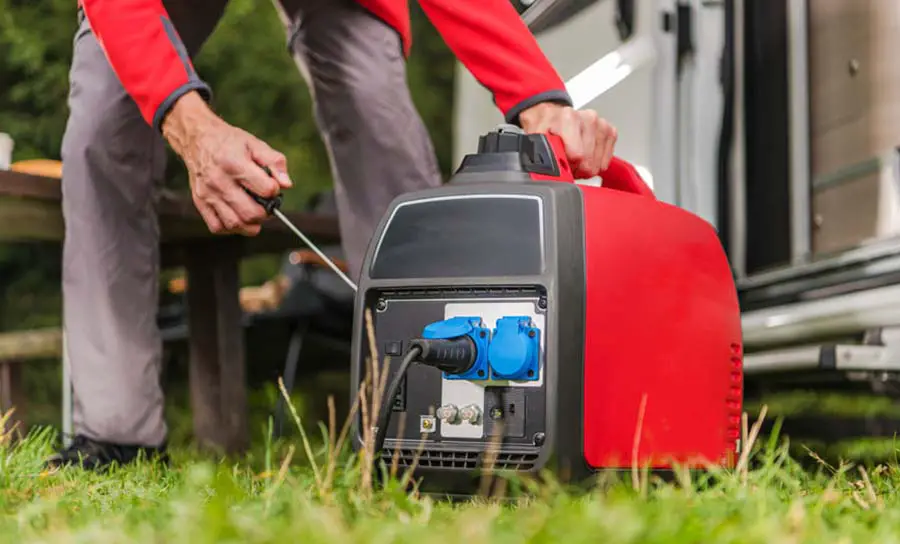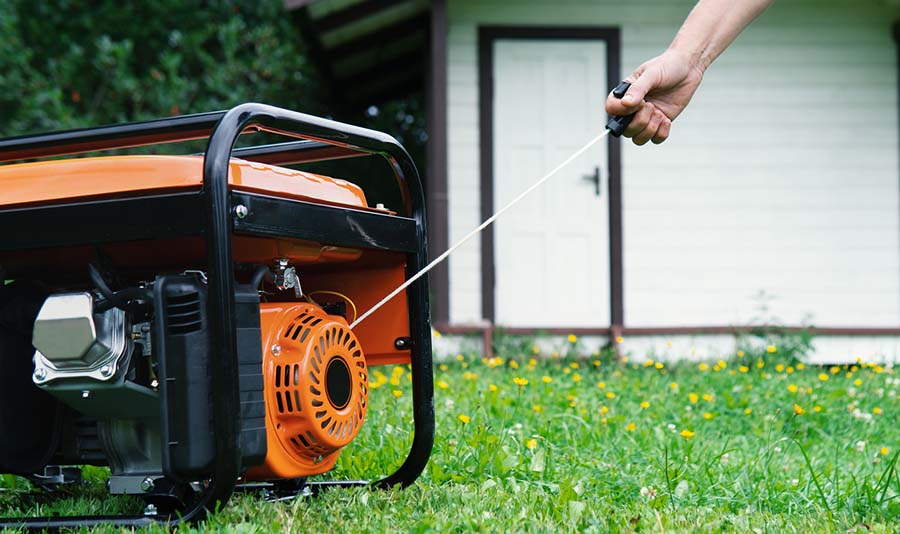
Starter ropes are crucial for getting your generator running and work well for the most part. But we have all experienced that moment when you reach to pull-start the generator, only to find it almost impossible to pull without lifting the generator off the ground. Here is what to do when your generator rope gets stiff and why it happens.
A stiff starter rope on a generator can result from a frayed cord, a hydrolocked engine, a seized piston, or a damaged flywheel. A frayed starter cord is usually the reason for the rope’s stiffness in most cases, and you can fix it by opening the recoil start assembly and replacing it entirely.
As mentioned above, many factors can cause a stiff or stuck starter rope. Luckily, there are many fixes, tricks, and tips for diagnosing and fixing the issue. All of this and more we will discuss below, so read on if you would like to know more about repairing your stiff generator starting rope and why it happens.
How Does a Starter Rope Work On a Generator?
It is always best to understand how something works before attempting to fix it. For this reason, I will briefly explain how a starter rope activates a generator and how to use it without causing damage to the generator, or the recoil start assembly.
Most recoil starter systems or pull start systems consist of a rope with a handle attached to one end of the cord. The cord’s end opposite the handle coils inside a reel held under tension by another reel with a spring. These two interconnecting reels are referred to as a reel assembly, with one end connected to the crankshaft through a ratcheting mechanism called a freewheel clutch.
When you pull the handle attached to the starter rope, the rope uncoils, tensions the spring, and engages the clutch while turning or spinning the crankshaft to activate the engine. The spring in the outer reel releases the tension when the handle is released and recoils the rope to prepare it for another start attempt.
There is a good reason the rope is not connected directly to the crankshaft. When the engine starts, the crankshaft will keep spinning, recoiling the rope violently enough to cause injury or damage to whatever is connected to the other end.
The older pull-start systems were comprised of a rope or cord with a handle attached at one end and the other end coiled around a notched reel connected directly to the crankshaft. When you pulled the rope, it would come free of the reel while spinning the crankshaft. If the engine did not start, you would have to rewind the wheel with the starter rope and pulled again.
Why Your Generator’s Rope Isn’t Working and How to Fix It

Now that we know how a recoil start assembly works, it is easier to understand where the problems may arise and how to solve them. Listed below are common malfunctions that occur with rope start systems and how to fix them. We’ll also discuss preventative measures that you can take to ensure you do not have to deal with a stiff generator rope during an emergency.
| Problem | Solution |
| Hydrolocked Engine | Take out the sparkplug and pull the rope repeatedly to clear the chamber. Do an oil change. |
| Damaged Flywheel or Flywheel Key | Replace the damaged or broken flywheel. Have a professional do it if you’re not proficient with motors. |
| Seized-Up Piston | Make sure there is enough oil and add some oil to the combustion chamber through the sparkplug hole |
Hydrolock
Hydrolock is one of the primary causes of stiff, stuck, or immobile starter ropes. Hydrolock occurs when liquid sits on top of the piston inside the generator’s engine’s combustion chamber. The liquid could be oil, gas, coolant, or water. Because the piston was designed to compress gasses and not liquids, it will render any attempt to start the engine futile and impossible.
Several things can cause an engine to hydrolock. The first is if the generator has been standing on an uneven surface. This will cause oil to seep past the piston rings on top of the pistons.
The second is if the carburetor is malfunctioning and gas seeps in through the bowl and leaks out the air filter side or back into the combustion chamber. This is also caused by storing your generator on an uneven surface. The third cause of hydrolock is water that can leak in if your generator weathered a rainstorm outside.
How to Diagnose and Fix a Hydrolocked Generator
To determine if you have hydrolock, remove the rubber boot from the spark plug and carefully unscrew it. Then inspect the inside to see if there is any liquid. Carefully pull on the start rope with your face away from the spark plug socket. If you can pull the rope, it means that you have hydrolock.
Next, you will need to determine which fluid is causing the hydrolock. Use a thin dowel with cloth taped to its end and carefully insert it into the spark plug socket. Remove the dowel and inspect the end. The liquid type will determine how to fix the generator.
If the cloth is covered with oil, you can flush it out by repeatedly pulling on the start rope. This will force the oil from the top of the piston. Once there is no more liquid spewing out, you can screw in the sparkplug, and the generator should fire up.
If the cloth is covered in gasoline, you will have to clean or replace the carburetor and change the oil, as the gas will have contaminated it. If you detect water on the cloth, you will have to flush the engine, as mentioned before, and replace the oil. The generator should fire up and run now.
Damaged or Cracked Flywheel or Flywheel Key
The flywheel is the mechanism that stores the power of the generator as rotational energy. The flywheel on a generator is behind the recoil starter assembly.
How to Diagnose and Fix a Damaged Flywheel on a Generator
To access it, remove the recoil starter assembly, and remove the starter cup and the fan disc. After you have removed the recoil starter assembly, you will see the flywheel connected to the crankshaft.
In the center where the flywheel connects to the crankshaft are the flywheel keys. Inspect the whole mechanism to determine if anything is cracked or damaged, causing it not to spin. If there is any damage, you must replace the flywheel and the flywheel keys.
Seized-Up Piston
A lack of oil or water leaking into the combustion chamber can cause a piston to seize up and rust. For this reason, it is essential to inspect the oil quality and levels of your generator regularly.
How to Diagnose and Fix a Seized-Up Piston on a Generator
If you think the piston has seized on your generator, you can attempt to fix it by ensuring enough oil is in the generator.
Next, remove the sparkplug rubber boot, unscrew the sparkplug and, put a tablespoon of oil into the combustion chamber. Let the oil soak for about an hour and gently pull on the starter rope with the spark plug still removed to see if the piston has freed itself. If the piston moves, keep pulling on the starter rope until the movement becomes smooth and even.
You should be able to run the generator after replacing the sparkplug. However, it is best to have the engine serviced to ensure no permanent damage to the piston cylinder.
If you run the generator without oil for an extensive amount of time, the piston will have fused to the cylinder. This will be because of the extreme heat generated. The piston might also rust to the cylinder because of water that seeped. Both of these scenarios will result in having to replace the engine or generator. So be sure to check your oil before you attempt to start your generator.
Recommended Generator Starter Rope Replacements
Most recoil starter assemblies come out with a standard braided nylon rope which can degrade and unravel with use. You might want to consider replacing the stock standard rope with a more durable high-end rope for a better option.
One of the most popular brands is Diamondcord because of its longevity and durability. Diamondcord comes with a lifetime guarantee, and the company claims that its starter ropes are five times stronger than steel. This is also why they are more expensive than other brands.
Another option is 5042K Briggs & Stratton. It’s a starter rope brand made specifically for recoil start engines and has a high abrasion resistance with a textured grip for easy pulling. It is easy to install and comes in a variety of sizes for other implementations. It is vastly cheaper than Diamondchord. However, it does not have a lifetime guarantee.
Conclusion
The best practice to avoid stiff generator ropes is regular maintenance and vigilance. Ensure that the generator is stored and run on a dry and level surface, that it has enough oil in it, that no water can leak through the exhaust and that the carburetor is functioning normally. This should prevent most of the malfunctions mentioned above.
